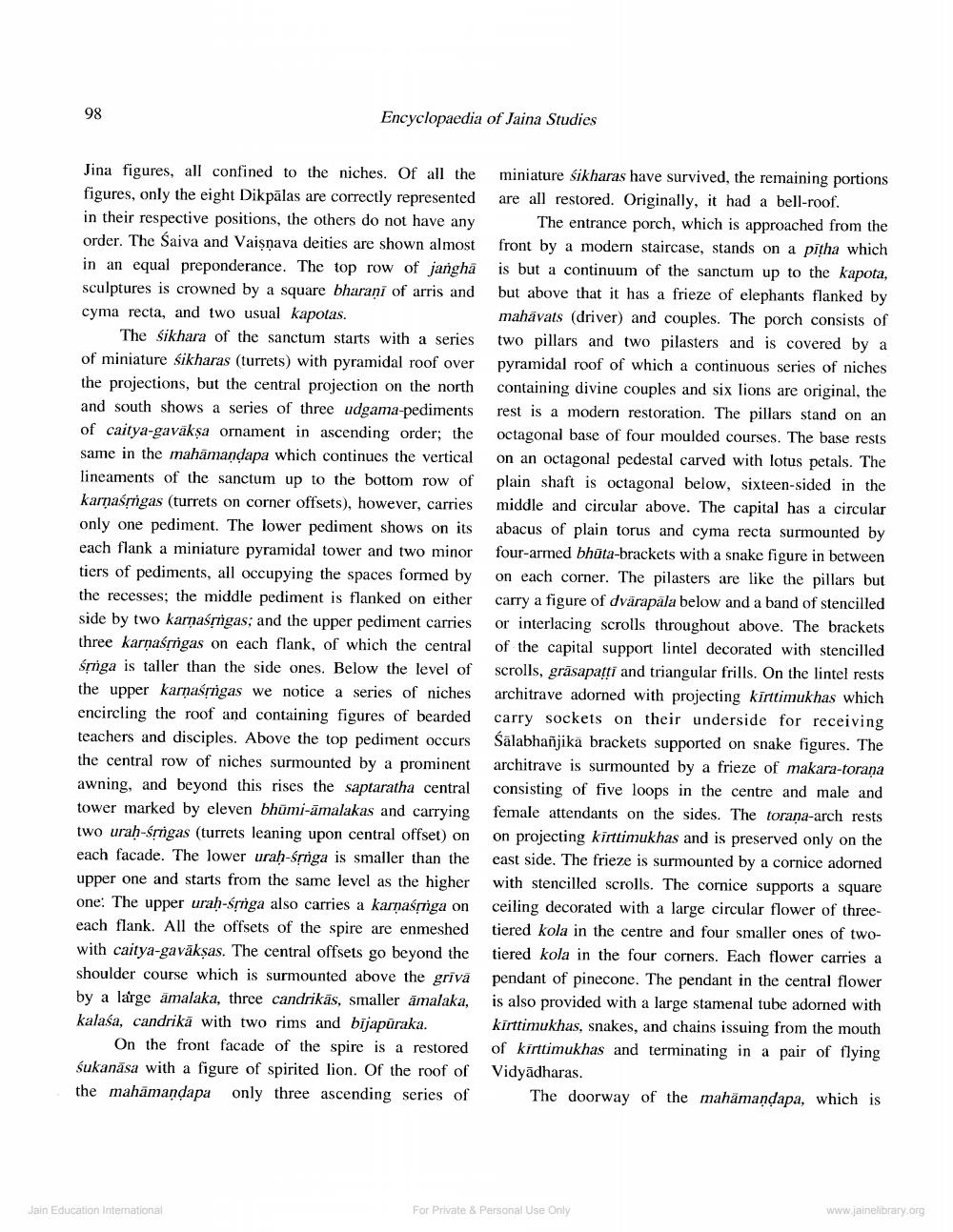________________
98
Encyclopaedia of Jaina Studies
Jina figures, all confined to the niches. Of all the figures, only the eight Dikpālas are correctly represented in their respective positions, the others do not have any order. The Saiva and Vaisnava deities are shown almost in an equal preponderance. The top row of jangha sculptures is crowned by a square bharaṇi of arris and cyma recta, and two usual kapotas.
The śikhara of the sanctum starts with a series of miniature sikharas (turrets) with pyramidal roof over the projections, but the central projection on the north and south shows a series of three udgama-pediments of caitya-gavākṣa ornament in ascending order; the same in the mahāmandapa which continues the vertical lineaments of the sanctum up to the bottom row of karnaśmigas (turrets on corner offsets), however, carries only one pediment. The lower pediment shows on its each flank a miniature pyramidal tower and two minor tiers of pediments, all occupying the spaces formed by the recesses; the middle pediment is flanked on either side by two karnaśrngas; and the upper pediment carries three karnaśmigas on each flank, of which the central śmga is taller than the side ones. Below the level of the upper karnaśmigas we notice a series of niches encircling the roof and containing figures of bearded teachers and disciples. Above the top pediment occurs the central row of niches surmounted by a prominent awning, and beyond this rises the saptaratha central tower marked by eleven bhümi-āmalakas and carrying two urah-śrrigas (turrets leaning upon central offset) on each facade. The lower urah-smiga is smaller than the upper one and starts from the same level as the higher one: The upper urah-śrriga also carries a karnassiga on each flank. All the offsets of the spire are enmeshed with caitya-gaväksas. The central offsets go beyond the shoulder course which is surmounted above the grīvā by a large amalaka, three candrikās, smaller amalaka, kalasa, candrikä with two rims and bijapūraka.
On the front facade of the spire is a restored śukanāsa with a figure of spirited lion. Of the roof of the mahāmandapa only three ascending series of
miniature sikharas have survived, the remaining portions are all restored. Originally, it had a bell-roof,
The entrance porch, which is approached from the front by a modern staircase, stands on a pītha which is but a continuum of the sanctum up to the kapota, but above that it has a frieze of elephants flanked by mahāvats (driver) and couples. The porch consists of two pillars and two pilasters and is covered by a pyramidal roof of which a continuous series of niches containing divine couples and six lions are original, the rest is a modern restoration. The pillars stand on an octagonal base of four moulded courses. The base rests on an octagonal pedestal carved with lotus petals. The plain shaft is octagonal below, sixteen-sided in the middle and circular above. The capital has a circular abacus of plain torus and cyma recta surmounted by four-armed bhüta-brackets with a snake figure in between on each corner. The pilasters are like the pillars but carry a figure of dvärapala below and a band of stencilled or interlacing scrolls throughout above. The brackets of the capital support lintel decorated with stencilled scrolls, grāsapatti and triangular frills. On the lintel rests architrave adorned with projecting kirttimukhas which carry sockets on their underside for receiving Salabhanjika brackets supported on snake figures. The architrave is surmounted by a frieze of makara-torana consisting of five loops in the centre and male and female attendants on the sides. The torana-arch rests on projecting kirttimukhas and is preserved only on the east side. The frieze is surmounted by a cornice adorned with stencilled scrolls. The cornice supports a square ceiling decorated with a large circular flower of threetiered kola in the centre and four smaller ones of twotiered kola in the four corners. Each flower carries a pendant of pinecone. The pendant in the central flower is also provided with a large stamenal tube adorned with kirttimukhas, snakes, and chains issuing from the mouth of kirttimukhas and terminating in a pair of flying Vidyādharas.
The doorway of the mahämandapa, which is
www.jainelibrary.org
Jain Education International
For Private & Personal Use Only




